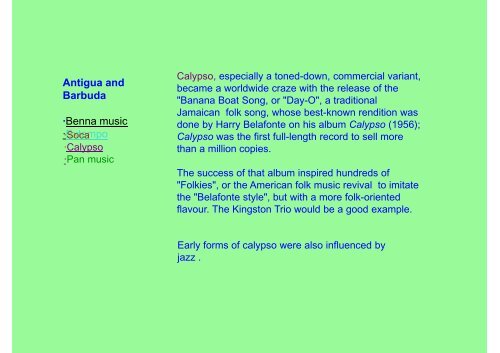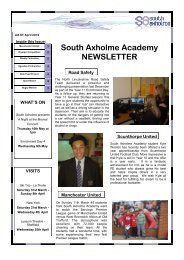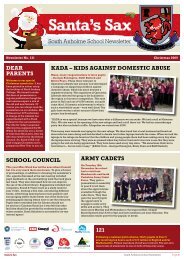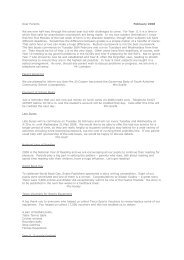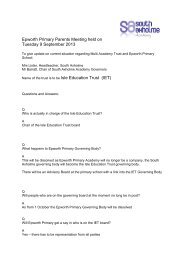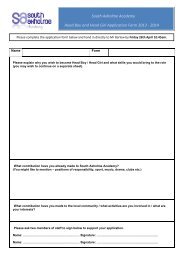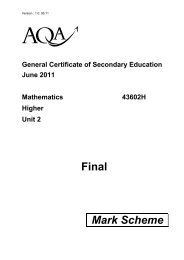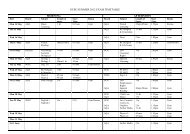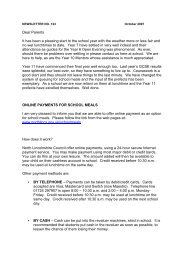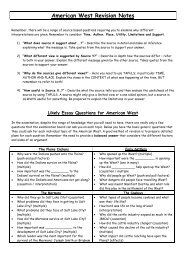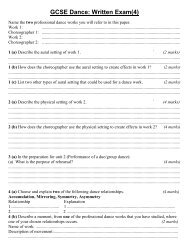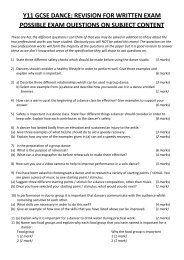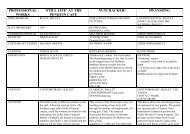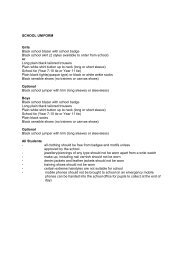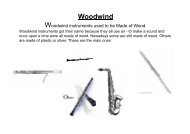Music of the Caribbean - Others a - South Axholme
Music of the Caribbean - Others a - South Axholme
Music of the Caribbean - Others a - South Axholme
Create successful ePaper yourself
Turn your PDF publications into a flip-book with our unique Google optimized e-Paper software.
Antigua and<br />
Barbuda<br />
·Benna music<br />
·Extempo ·Soca<br />
·Calypso<br />
·Pan music<br />
Calypso, especially a toned-down, commercial variant,<br />
became a worldwide craze with <strong>the</strong> release <strong>of</strong> <strong>the</strong><br />
"Banana Boat Song, or "Day-O", a traditional<br />
Jamaican folk song, whose best-known rendition was<br />
done by Harry Belafonte on his album Calypso (1956);<br />
Calypso was <strong>the</strong> first full-length record to sell more<br />
than a million copies.<br />
The success <strong>of</strong> that album inspired hundreds <strong>of</strong><br />
"Folkies", or <strong>the</strong> American folk music revival to imitate<br />
<strong>the</strong> "Belafonte style" , but with a more folk-oriented<br />
flavour. The Kingston Trio would be a good example.<br />
E l f f l l i fl d b<br />
Early forms <strong>of</strong> calypso were also influenced by<br />
jazz .
Antigua and Barbuda<br />
Extempo (also extempo calypso) is a lyrically<br />
improvised form <strong>of</strong> calypso and is most notably<br />
·Benna music<br />
practised in Trinidad and Tobago. It consists <strong>of</strong> a<br />
·Extempo<br />
performer improvising in song or in rhythmic<br />
·Soca<br />
speech on a given <strong>the</strong>me before an audience who<br />
·Calypso<br />
<strong>the</strong>mselves take turns to perform. It is inherently<br />
·Pan music<br />
competitive and success is judged by <strong>the</strong> wit and<br />
ingenuity <strong>of</strong> <strong>the</strong> performance.<br />
Benna is an uptempo Antiguan folk song that was introduced following <strong>the</strong><br />
prohibition <strong>of</strong> slavery. Songs usually focused on scandalous and bawdy rumors and<br />
gossip, and were in a call-and-response form with a leader and an audience.<br />
Benna's popularity and similarity to calypso helped make <strong>the</strong> island receptive to that<br />
genre's introduction.
Bahamas<br />
·Junkanoo<br />
·Rake and Scrape<br />
·Goombay<br />
Ripsaw is a musical genre which originated in <strong>the</strong> Turks and Caicos<br />
Islands, specifically in <strong>the</strong> Middle and North Caicos. A very closely<br />
related variant, rake-and-scrape, is played in <strong>the</strong> Bahamas. Its<br />
most distinctive characteristic is <strong>the</strong> use <strong>of</strong> <strong>the</strong> common handsaw as<br />
<strong>the</strong> primary instrument, along with various kinds <strong>of</strong> drums , box<br />
guitar, concertina, triangle and accordion.<br />
The saw is played by scraping an object, usually an old knife blade,<br />
along <strong>the</strong> saw's teeth. The sound is similar to a paper being ripped,<br />
and is believed to be <strong>the</strong> origin <strong>of</strong> <strong>the</strong> term ripsaw. Rake-and-scrape<br />
derives from <strong>the</strong> method used by a player to create sound from <strong>the</strong><br />
saw.<br />
Junkanoo is a street parade with music, which occurs in many towns across The Bahamas<br />
and The Turks and Caicos Islands every Boxing Day (December 26), New Year's Day and,<br />
more recently, in <strong>the</strong> summer on <strong>the</strong> island <strong>of</strong> Grand Bahama.<br />
Goombay is a form <strong>of</strong> Bahamian music and a drum used to create it. The goombay drum is a<br />
membranophone with one goat skin head held between <strong>the</strong> legs and played with <strong>the</strong> hands or<br />
sticks.
ecame a worldwide craze with <strong>the</strong> release <strong>of</strong> <strong>the</strong> "Banana Boat<br />
Song, or "Day-O", a traditional Jamaican folk song<br />
a street parade with music, which occurs in many towns across The<br />
Bahamas and The Turks and Caicos Islands every Boxing Day<br />
(December 26), New Year's Early Day forms and, <strong>of</strong> calypso more recently, were also in influenced <strong>the</strong> summer by jazz .<br />
on <strong>the</strong> island <strong>of</strong> Grand Bahama.<br />
consists <strong>of</strong> a performer improvising in song or in rhythmic speech on<br />
a given <strong>the</strong>me before an audience who <strong>the</strong>mselves take turns to<br />
perform.<br />
Its most distinctive characteristic is <strong>the</strong> use <strong>of</strong> <strong>the</strong> common handsaw<br />
as <strong>the</strong> primary instrument, along with various kinds <strong>of</strong> drums , box<br />
guitar, concertina, triangle and accordion.<br />
an uptempo Antiguan folk song that was introduced following <strong>the</strong><br />
prohibition <strong>of</strong> slavery. Songs usually focused on scandalous and<br />
bawdy rumors and gossip, and were in a call-and-response form with<br />
a leader and an audience.<br />
a form <strong>of</strong> Bahamian music and a drum used to create it.<br />
Goombay Extempo Calypso<br />
Ripsaw<br />
Junkanoo<br />
Benna
Answers<br />
became a worldwide craze with <strong>the</strong> release <strong>of</strong> <strong>the</strong> "Banana Boat<br />
Song, or "Day-O", a traditional Jamaican folk song<br />
Calypso<br />
a street parade with music, which occurs in many towns across The Junkanoo<br />
Bahamas and The Turks and Caicos Islands every Boxing Day<br />
(December 26), New Year's Early Day forms and, <strong>of</strong> calypso more recently, were also in influenced <strong>the</strong> summer by jazz .<br />
on <strong>the</strong> island <strong>of</strong> Grand Bahama.<br />
consists <strong>of</strong> a performer improvising in song or in rhythmic speech on<br />
a given <strong>the</strong>me before an audience who <strong>the</strong>mselves take turns to<br />
perform.<br />
Its most distinctive characteristic is <strong>the</strong> use <strong>of</strong> <strong>the</strong> common handsaw<br />
as <strong>the</strong> primary instrument, along with various kinds <strong>of</strong> drums , box<br />
guitar, concertina, triangle and accordion.<br />
an uptempo Antiguan folk song that was introduced following <strong>the</strong><br />
prohibition <strong>of</strong> slavery. Songs usually focused on scandalous and<br />
bawdy rumors and gossip, and were in a call-and-response form with<br />
a leader and an audience.<br />
a form <strong>of</strong> Bahamian music and a drum used to create it.<br />
Extempo<br />
Ripsaw<br />
Benna<br />
Goombay
Dominica<br />
·Bélé<br />
·Bouyon music<br />
·Cadence-lypso<br />
·Compas<br />
·Jing-Ping<br />
·Soca<br />
Soca, is Trinidad and Tobago's domestically developed<br />
genuine popular music, with an unusually large amount<br />
<strong>of</strong> musical roots. The most known song is maybe<br />
"(Feelin') Hot Hot Hot", <strong>the</strong> title <strong>of</strong> a soca song from<br />
1982 by Arrow, (Alphonsus Cassell).<br />
A bélé is a folk song and dance from Dominica, performed<br />
most commonly during full moon evenings, or sometimes<br />
during funeral wakes. All bélé are accompanied by an<br />
eponymous drum, <strong>the</strong> tanbou bélé (also called tambour bélé or<br />
bélé drum), along with <strong>the</strong> tingting (triangle) and chakchak<br />
(maracas).
Dominica<br />
·Bélé<br />
·Bouyon music<br />
·Cadence-lypso<br />
·Compas<br />
·Jing-Ping<br />
·Soca<br />
Bouyon music is a mix <strong>of</strong> traditional<br />
and modern music, and is popular<br />
across much <strong>of</strong> <strong>the</strong> <strong>Caribbean</strong>.<br />
Cadence-lypso, popularized as simply<br />
Cadence is a genre <strong>of</strong> music from Dominica.<br />
i<br />
Jing Ping is a kind <strong>of</strong> folk music originated on <strong>the</strong> slave plantations <strong>of</strong><br />
Dominica, also known colloquially as an accordion band. In Dominican folk<br />
music, jing ping bands accompany a circle dance called <strong>the</strong> flirtation, as well<br />
as <strong>the</strong> Dominican i quadrille. Jing ping bands are made up <strong>of</strong> a boumboum, b<br />
syak or gwaj (scraper ) -rattle, tambal or tanbou (tambourine) and accordion.<br />
The double bass and banjo are also sometimes used. Bamboo flutes led <strong>the</strong><br />
jing ping ensembles before <strong>the</strong> 1940s, when accordions were introduced.
Dominican Republic<br />
·Bachata<br />
ata<br />
Merengue típico (also known as merengue cibaeño or<br />
·Gaga<br />
colloquially as Perico ripiao) is a musical genre <strong>of</strong> <strong>the</strong><br />
·Merengue Dominican Republic. Merengue tipico is <strong>the</strong> term preferred by<br />
·Perico Ripiao most musicians as it is more respectful and emphasizes <strong>the</strong><br />
·Latin Rap music's traditional nature.<br />
·Salsa<br />
·Reggaeton - Reggae sub-genre<br />
Guyana<br />
Shanto is a form <strong>of</strong> Guyanese music, related to both calypso<br />
and mento. It became a major part <strong>of</strong> early popular music<br />
·Calypso<br />
through its use in Guyanese vaudeville shows; songs are<br />
·Chutney topical and light-hearted, <strong>of</strong>ten accompanied by a guitar.<br />
·Chutney-soca<br />
·Dancehall - reggae sub-genre<br />
·Reggae<br />
·Soca<br />
·Shanto<br />
·Steel Pan
The most known song is maybe "(Feelin') Hot Hot Hot",<br />
A genre <strong>of</strong> music from Dominica.<br />
Also known as merengue cibaeño or colloquially as Perico<br />
ripiao) is a musical genre <strong>of</strong> <strong>the</strong> Dominican Republic.<br />
A folk song and dance from Dominica, performed most<br />
commonly during full moon evenings, or sometimes during<br />
funeral wakes.<br />
In Dominican folk music, jing ping bands accompany a circle<br />
dance called <strong>the</strong> flirtation, as well as <strong>the</strong> Dominican quadrille.<br />
A mix <strong>of</strong> traditional and modern music, and is popular across<br />
much <strong>of</strong> <strong>the</strong> <strong>Caribbean</strong>.<br />
A form <strong>of</strong> Guyanese music, related to both calypso and mento. It<br />
became a major part <strong>of</strong> early popular music through its use in<br />
Guyanese vaudeville shows; songs are topical and light-hearted,<br />
<strong>of</strong>ten accompanied by a guitar.<br />
Shanto<br />
Jing Ping<br />
Merengue típico<br />
Soca<br />
Bouyon music<br />
bélé<br />
Cadence-lypso
Answers<br />
The most known song is maybe "(Feelin') Hot Hot Hot",<br />
A genre <strong>of</strong> music from Dominica.<br />
Also known as merengue cibaeño or colloquially as Perico ripiao)<br />
is a musical genre <strong>of</strong> <strong>the</strong> Dominican Republic.<br />
A folk song and dance from Dominica, performed most commonly<br />
during full moon evenings, or sometimes during funeral wakes.<br />
In Dominican folk music, jing ping bands accompany a circle dance<br />
called <strong>the</strong> flirtation, ti as well as <strong>the</strong> Dominican i quadrille.<br />
A mix <strong>of</strong> traditional and modern music, and is popular across much<br />
<strong>of</strong> <strong>the</strong> <strong>Caribbean</strong>.<br />
A form <strong>of</strong> Guyanese music, related to both calypso and mento. It<br />
became a major part <strong>of</strong> early popular music through its use in<br />
Guyanese vaudeville shows; songs are topical and light-hearted,<br />
<strong>of</strong>ten accompanied by a guitar.<br />
Soca<br />
Cadence-lypso<br />
Merengue típico<br />
bélé<br />
Jing Ping<br />
Bouyon music<br />
Shanto<br />
Shanto<br />
Jing Ping<br />
Merengue típico<br />
Soca<br />
Bouyon music<br />
bélé<br />
Cadence-lypso
Haiti<br />
·Compas<br />
·Cadence rampa<br />
·Haitian hip hop<br />
·Kadans<br />
·Mini-jazz<br />
i ·Mizik rasin<br />
·Méringue<br />
·Rara<br />
·Zouk<br />
Cadence rampa is a variety <strong>of</strong> music from <strong>the</strong><br />
<strong>Caribbean</strong> country <strong>of</strong> Haïti. Cadence rampa is<br />
originally a modern Haitian Méringue popularized by<br />
<strong>the</strong> talented sax player Webert Sicot in <strong>the</strong> early 60s.<br />
When Sicot left Nemours Jean Baptiste Compas band<br />
he called his music cadence to differentiate it from<br />
Compas, however, ei<strong>the</strong>r compas or cadence is a<br />
modern Méringue.<br />
Haitian i Hip Hop or Hip Hop Kreyol is music<br />
originating from Haiti and sung by artists <strong>of</strong> Haitian<br />
descent. The most popular form <strong>of</strong> this is <strong>the</strong> rising <strong>of</strong><br />
'Hip Hop nan Kreyòl' or Kreyòl Hip Hop. Often,<br />
hardcore beats are used while <strong>the</strong> artist raps in kreyòl.<br />
Kreyòl hip hop, though relatively new, has become<br />
very popular with Haitian youth.
Haiti<br />
·Compas<br />
·Cadence C d rampa<br />
·Haitian hip hop<br />
·Kadans<br />
·Mini-jazz<br />
·Mizik rasin<br />
·Méringue<br />
·Rara<br />
·Zouk<br />
Kadans is <strong>the</strong> Creole term for Cadence. Kadans is a<br />
French Creole music genre, which started <strong>of</strong>f in Haïti,<br />
and made popular in <strong>the</strong> French islands <strong>of</strong> Martinique.<br />
and Guadeloupe.<br />
The Mini jazz movement started in <strong>the</strong> mid-1960s, small<br />
bands called mini-djaz played konpa featuring paired<br />
electric guitars, electric bass, drumset and o<strong>the</strong>r percussion,<br />
<strong>of</strong>ten with a saxophone.<br />
Rasin is a musical movement that began in Haïti in 1987 when musicians began<br />
combining elements <strong>of</strong> traditional Haïtian vodou ceremonical and folkloric music with rock<br />
and roll. This style <strong>of</strong> modern music reaching back to <strong>the</strong> roots <strong>of</strong> vodou tradition came to<br />
be called mizik rasin.<br />
Originating in Haïti, rara is a form <strong>of</strong> festival music used for street processions,<br />
typically during Easter Week. The music centers on a set <strong>of</strong> cylindrical i l bamboo b<br />
trumpets called vaksen (which may also be made <strong>of</strong> metal pipes), but also<br />
features drums, maracas, guiros, and metal bells, as well as sometimes also<br />
cylindrical metal trumpets which are made from recycled metal, <strong>of</strong>ten c<strong>of</strong>fee cans.
musicians began combining elements <strong>of</strong> traditional Haïtian vodou<br />
ceremonical and folkloric music with rock and roll.<br />
a variety <strong>of</strong> music from <strong>the</strong> <strong>Caribbean</strong> country <strong>of</strong> Haïti. Cadence rampa is<br />
originally a modern Haitian Méringue popularized by <strong>the</strong> talented sax<br />
player Webert Sicot in <strong>the</strong> early 60s.<br />
small bands called mini-djaz played konpa featuring paired electric<br />
guitars, electric bass, drumset and o<strong>the</strong>r percussion, <strong>of</strong>ten with a<br />
saxophone.<br />
music originating from Haiti and sung by artists <strong>of</strong> Haitian descent.<br />
a form <strong>of</strong> festival music used for street processions, typically y during<br />
Easter Week. The music centers on a set <strong>of</strong> cylindrical bamboo trumpets<br />
called vaksen (which may also be made <strong>of</strong> metal pipes), but also features<br />
drums, maracas, guiros, and metal bells, as well as sometimes also<br />
cylindrical metal trumpets which are made from recycled metal, <strong>of</strong>ten<br />
c<strong>of</strong>fee cans.<br />
a French Creole music genre, which started <strong>of</strong>f in Haïti, and made<br />
popular in <strong>the</strong> French islands <strong>of</strong> Martinique. and Guadeloupe.<br />
Cadence rampa<br />
rara<br />
Rasin<br />
Kadans<br />
Mini jazz<br />
Haitian Hip Hop
Answers<br />
musicians began combining elements <strong>of</strong> traditional Haïtian vodou<br />
ceremonical and folkloric music with rock and roll.<br />
a variety <strong>of</strong> music from <strong>the</strong> <strong>Caribbean</strong> country <strong>of</strong> Haïti. Cadence rampa is<br />
originally a modern Haitian Méringue popularized by <strong>the</strong> talented sax<br />
player Webert Sicot in <strong>the</strong> early 60s.<br />
small bands called mini-djaz played konpa featuring paired electric<br />
guitars, electric bass, drumset and o<strong>the</strong>r percussion, <strong>of</strong>ten with a<br />
saxophone.<br />
music originating from Haiti and sung by artists <strong>of</strong> Haitian descent.<br />
a form <strong>of</strong> festival music used for street processions, typically during<br />
Easter Week. The music centers on a set <strong>of</strong> cylindrical bamboo trumpets<br />
called vaksen (which may also be made <strong>of</strong> metal pipes), but also<br />
features drums, maracas, guiros, and metal bells, as well as sometimes<br />
also cylindrical metal trumpets which are made from recycled metal,<br />
<strong>of</strong>ten c<strong>of</strong>fee cans.<br />
a French Creole e music genre, e, which started ted <strong>of</strong>f in Haïti, at, and made<br />
popular in <strong>the</strong> French islands <strong>of</strong> Martinique. and Guadeloupe.<br />
Rasin<br />
Cadence<br />
rampa<br />
Mini jazz<br />
Haitian Hip<br />
Hop<br />
rara<br />
Kadans
Jamaica<br />
·Dancehall - reggae sub-genre<br />
·Dub - reggae sub-genre<br />
·Kumina<br />
·Lovers rock - reggae sub-genre<br />
·Mento<br />
·Ragga - reggae sub-genre<br />
·Reggae<br />
·Rocksteady - reggae sub-genre<br />
·Roots reggae - reggae sub-genre<br />
·Ska<br />
·Soca<br />
Kumina or Cumina is a cultural form indigenous to<br />
Jamaica. It is a religion, music and dance practiced<br />
by in large part Jamaicans who reside in <strong>the</strong><br />
eastern parish on St. Thomas on <strong>the</strong> island. These<br />
people have retained <strong>the</strong> drumming and dancing <strong>of</strong><br />
<strong>the</strong> Akan people.<br />
Mento is a style <strong>of</strong> Jamaican folk music that t<br />
predates and has greatly influenced ska and<br />
reggae music. Mento typically features acoustic<br />
instruments, such as acoustic guitar, banjo,<br />
hand drums, and <strong>the</strong> rhumba box — a large<br />
mbira in <strong>the</strong> shape <strong>of</strong> a box that can be sat on<br />
while played. The rhumba box carries <strong>the</strong> bass<br />
part <strong>of</strong> <strong>the</strong> music.
Ska and Rock Steady are both styles <strong>of</strong> music from Jamaica.<br />
Ska:<br />
·· Emerged in <strong>the</strong> 1950s / 1960s<br />
·· Words are about local issues<br />
·· Fast music with <strong>of</strong>f-beat rhythms<br />
·· Developed from Mento<br />
·· The <strong>Music</strong> uses amplified and electric instruments like <strong>the</strong><br />
1960s African-American Rhythm ‘n’ Blues<br />
Rock Steady:<br />
·· Came after Ska<br />
·· Slower than Ska<br />
·· Made more use <strong>of</strong> bass riffs in <strong>the</strong> bass guitar<br />
·· Kept <strong>of</strong>f-beat chords <strong>of</strong> Ska<br />
·· Still concerned with serious social issues<br />
.
Ska and Rock Steady are both styles <strong>of</strong> music from Jamaica.<br />
Ska is a music genre that originated in Jamaica in <strong>the</strong> 1950s<br />
/ 1960s, and was <strong>the</strong> precursor to rocksteady and reggae.<br />
Ska combined elements <strong>of</strong> <strong>Caribbean</strong> mento and calypso<br />
with American and rhythm and blues. It is characterized by a<br />
walking bass line accented with rhythms on <strong>the</strong> upbeat. In<br />
<strong>the</strong> early 1960s, ska was <strong>the</strong> dominant music genre <strong>of</strong><br />
Jamaica and was popular with British mods. Later it became<br />
popular with many skinheads. Typical instruments are guitar,<br />
bass guitar, trumpet, trombone, saxophone, piano, drums,<br />
organ.<br />
.
a style <strong>of</strong> Jamaican folk music that predates and has greatly<br />
influenced ska and reggae music. Mento typically features acoustic<br />
instruments, such as acoustic guitar, banjo, hand drums, and <strong>the</strong><br />
rhumba box - a large mbira in <strong>the</strong> shape <strong>of</strong> a box that can be sat on<br />
while played. The rhumba box carries <strong>the</strong> bass part <strong>of</strong> <strong>the</strong> music.<br />
a religion, music and dance practiced by in large part Jamaicans who<br />
reside in <strong>the</strong> eastern parish on St. Thomas on <strong>the</strong> island. These<br />
people have retained <strong>the</strong> drumming and dancing <strong>of</strong> <strong>the</strong> Akan people.<br />
combined elements <strong>of</strong> <strong>Caribbean</strong> mento and calypso with American<br />
and rhythm and blues. It is characterized by a walking bass line<br />
accented with rhythms on <strong>the</strong> upbeat. Typical instruments are guitar,<br />
bass guitar, trumpet, trombone, saxophone, piano, drums, organ.<br />
Ska<br />
Mento Kumina or Cumina
Answers<br />
a style <strong>of</strong> Jamaican folk music that predates and has greatly<br />
influenced ska and reggae music. Mento typically features acoustic<br />
instruments, such as acoustic guitar, banjo, hand drums, and <strong>the</strong><br />
rhumba box - a large mbira in <strong>the</strong> shape <strong>of</strong> a box that can be sat<br />
on while played. The rhumba box carries <strong>the</strong> bass part <strong>of</strong> <strong>the</strong><br />
music.<br />
a religion, music and dance practiced by in large part Jamaicans<br />
who reside in <strong>the</strong> eastern parish on St. Thomas on <strong>the</strong> island.<br />
These people have retained <strong>the</strong> drumming and dancing <strong>of</strong> <strong>the</strong> Akan<br />
people.<br />
combined elements <strong>of</strong> <strong>Caribbean</strong> mento and calypso with American<br />
and rhythm and blues. It is characterized by a walking bass line<br />
accented with rhythms on <strong>the</strong> upbeat. Typical instruments are<br />
guitar, bass guitar, trumpet, trombone, saxophone, piano, drums,<br />
organ.<br />
Mento<br />
Kumina or<br />
Cumina<br />
Ska


